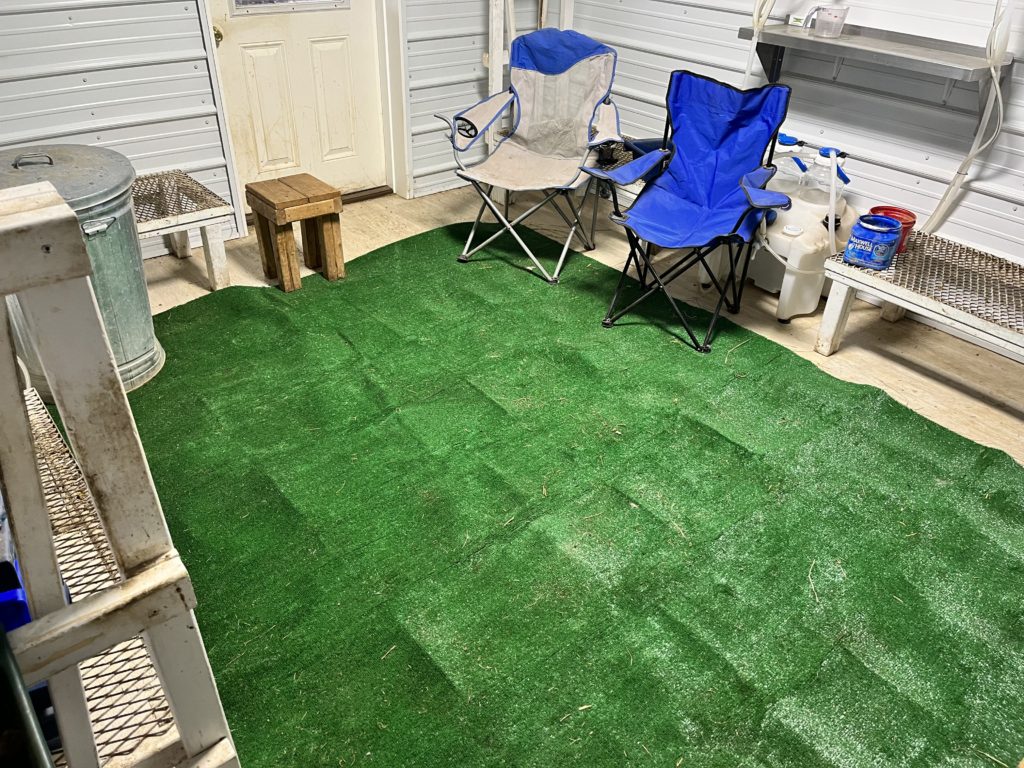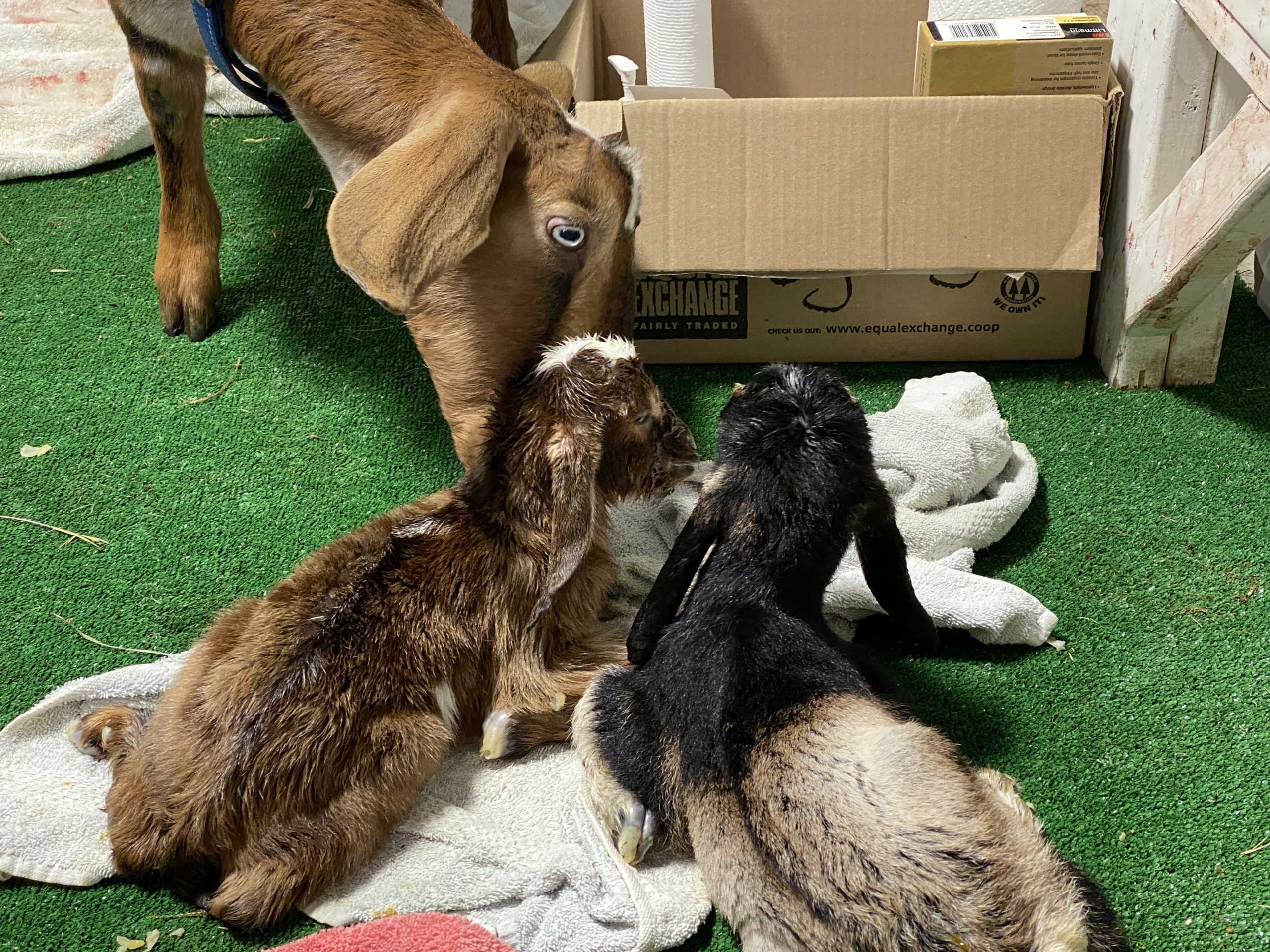
PART 1: Preparing for Kids!
It’s the time of year when many of us are expecting goat kids, so I thought I’d put together a primer for newbies. I make no claims to be an expert, but am just trying to share how we do things, and offer a few lists and tips. This turned into a three-part series.
Linked here is the second part in this series: Part 2: Normal Labor and Delivery
I so remember my first kidding season. We bought two pregnant does to start our herd, and our very first kid got stuck in her mom. When we finally got her out, she had stopped breathing. My husband, Scott, gave her mouth to mouth resuscitation for over half an hour.
When we called to say that we wouldn’t be making it to our Care Group, our pastor, who had raised sheep all his life, advised us to put this kid into a styrofoam box with a hair dryer blowing on her to warm her up.
She finally made it through all this! Her name is JC’s Bluebelle 3*P, and she’s been one of our best dams ever since. Here are Scott and Bluebelle, days after the birth.
As we are starting our fifth kidding season, I thought I would share some basic information for those who are just starting out. Many have written much more comprehensive articles on this subject (and books). I’m not an expert by any means! But I have had preemie kids (who we lost) and tangled kids, most of whom we’ve pulled through, but not all. Birth is a scary business, and all the more so when you are just starting out. My prayer as I write is that this will help someone to have more confidence, and/or knowledge, as they enter their first kidding season.
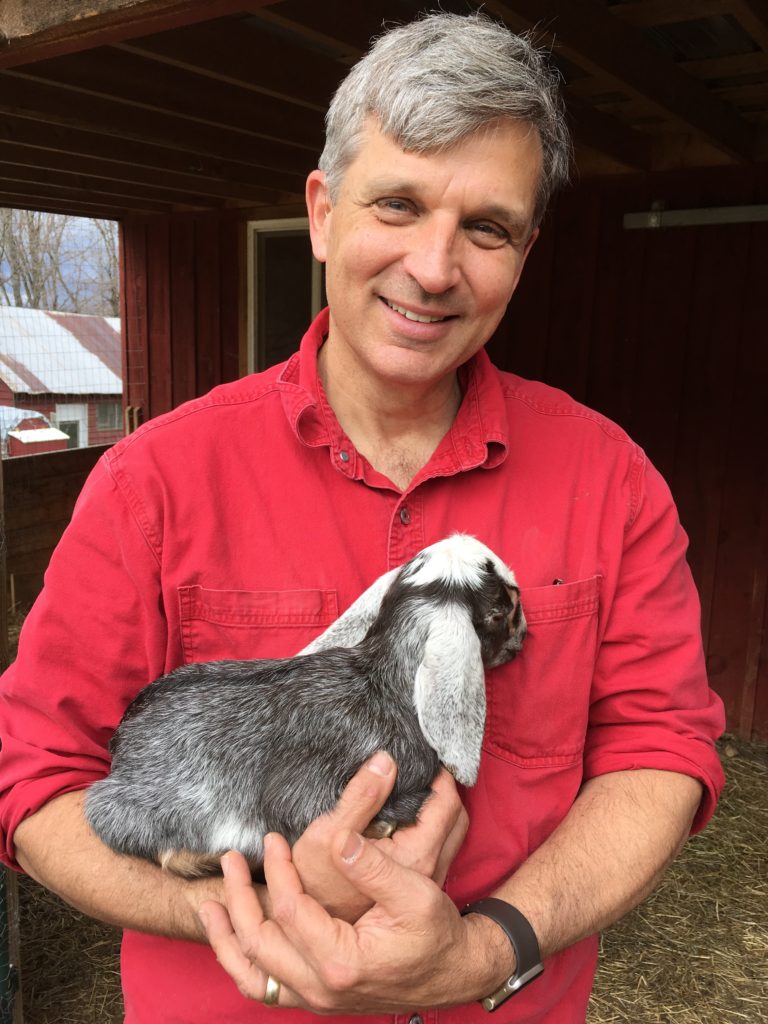
Prenatal Care of Expectant Dams
We have a chart that I create each year. The information here is then also transferred to my day timer calendar.
A picture of this chart goes onto our cell phones for easy reference in the barn, but it’s also helpful to me to have it where it can be cross checked and a reminder in the day timer.
For each doe, here is our care list, counted back from a due date that is figured at 150 days from breeding.
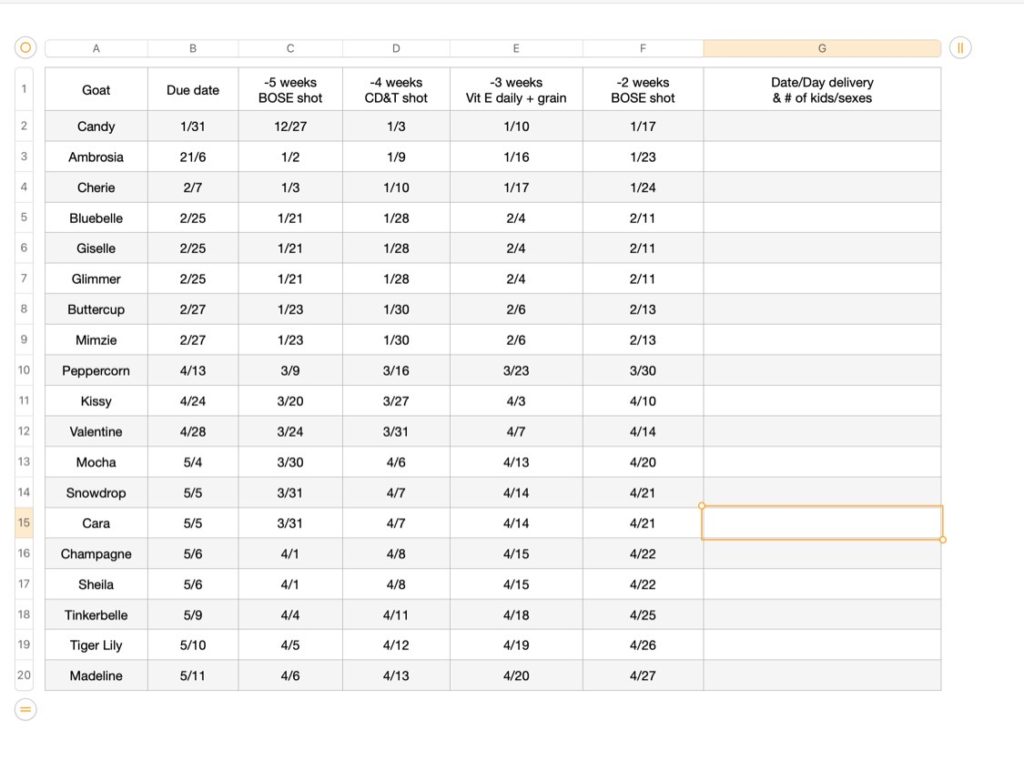
- 5 weeks before delivery: BOSe shot (Vitamin E and selenium shot: read more here)
- 4 weeks before delivery: CD&T shot (this will cover kids from tetanus during disbudding)
- 3 weeks before delivery:
- Start feeding a handful of grain 1X/day to get the rumen ready for bigger feedings immediately post partum. In this grain, we put one Vitamin E liquid capsule (cut open) and a small handful of red raspberry leaves. The grain gradually increases to about 1 cup/day until delivery. We find that we’ve never had pregnancy toxemia using this protocol.
- We also start pregnant dams on alfalfa hay around this time. Since we have 20+ does kidding, this is not as strictly controlled, since they all eat together. We usually house about 10-15 of the does nearest delivery together, and feed one bale of alfalfa to all each morning, then feed high quality grass hay through the day.
- 2 weeks before delivery: another BOSe shot
One more note about prenatal care: For our first 2.5 years of kidding we used various brands of loose, all-in-one, goat minerals. In our first kidding season, we frequently saw kids with weak front legs, or kids who “walked on their knuckles” — really, their pasterns. Both of these conditions required splinting.
In our third season, we switched to a free-choice mineral bar. We have seen a marked change ever since. We have had extremely healthy, vigorous kids ever since, and not one has needed splinting, or walked on their pasterns. Additionally, our does have had glossier coats and brighter eyes overall.

Getting Ready for Kids
When I was starting, I spent an entire day searching out and watching every single goat birth video on YouTube or blogs. It really DID help. I saw normal birth after normal birth. Some videos showed tips and tricks that helped. Almost none of them showed troubled births because, well, if things are going awry, there’s not always the desire or attention to give to capturing events on film.
I also gathered supplies specific to kidding. I gathered far more than I needed, so this list is in order of things that we really use almost every time, down to things we are sure glad to have when we need them!
Equipment for Normal Deliveries
Barn Cameras: Top of my list. Saves us so much sleep and so many steps. I wrote a whole blog post on ours, and you can search to find tons of articles on various systems, from baby monitors to security cameras. Do it! (You can thank me later!)
Towels. We use 4-6 bath towels, and 1-2 hand towels per birth. We wash them afterwards, and use them each year. We keep them in a tote from year to year, and just pull it out with the first kids.
Hand Sanitizer, or better, soap and hot water, for sanitizing hands before you go inside a goat. Put it in a bucket and have it handy as the goat goes into serious labor.
KY Jelly: Lubricant to be used AFTER cleansing hands, or with gloves.
Bulb syringe (also called a nose sucker) to help clear mucus from nostrils and throats of baby goats.
Gloves (throw away, latex or other kind). I don’t always use gloves, as in hairy situations they can impair my grip on tangled kids. I soap up and go in without them. But, we always give LA200 antibiotics to does whom I have had to enter deeply, regardless of whether or not I was wearing gloves.
Iodine: because you need to dip the kids’ cords in iodine as quickly after birth as is practical. Find a container about 1″ deep with a lid and use the same 1/2 cup full for the season.
Scissors: for cutting a cord. Mostly never used.
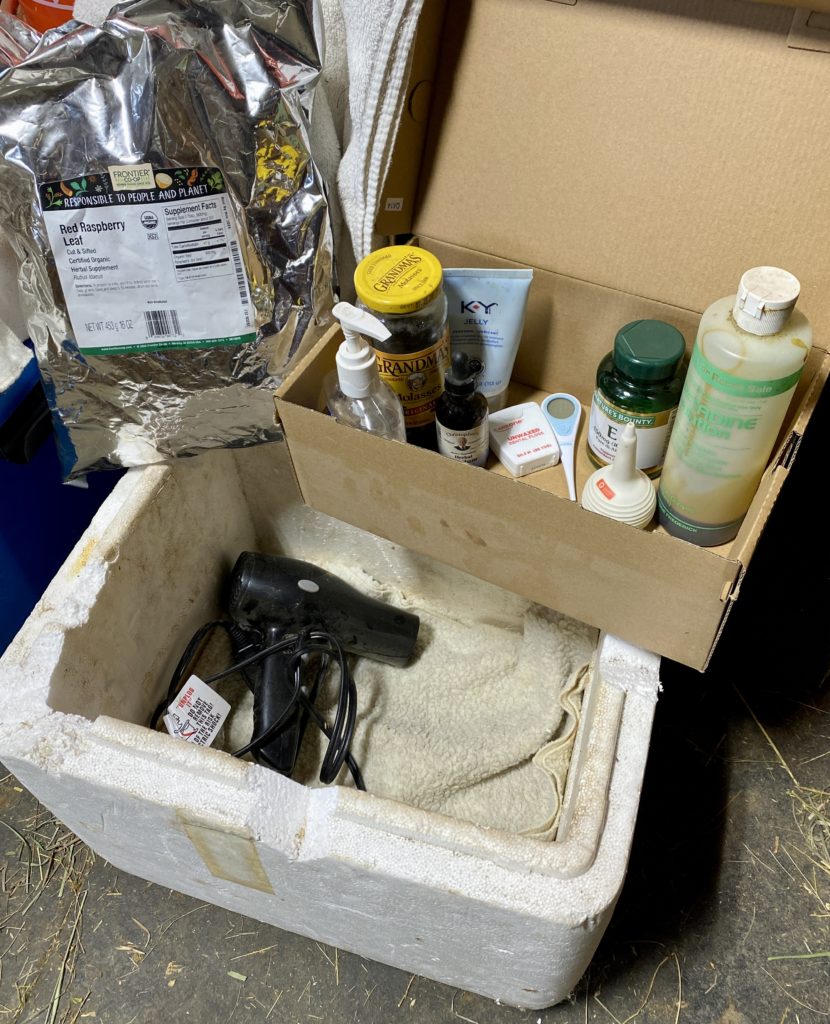
Supplements
Red raspberry leaves and molasses: to make a post partum tea for does. The sugar restores their energy and the raspberry leaves help the uterus to contract and expel the placenta. Put the leaves into a colander and thence into hot water in a pot to brew the tea while the goat is in advanced labor.
When she finishes, serve it warm with a big dollop of molasses stirred in. Most of them LOVE this brew!
Herbal calcium drops: Can help does during long labors or pushing sessions with added calcium. It helps the uterus to contract. I administer two dropperfuls at 30-minute intervals during protracted labor.
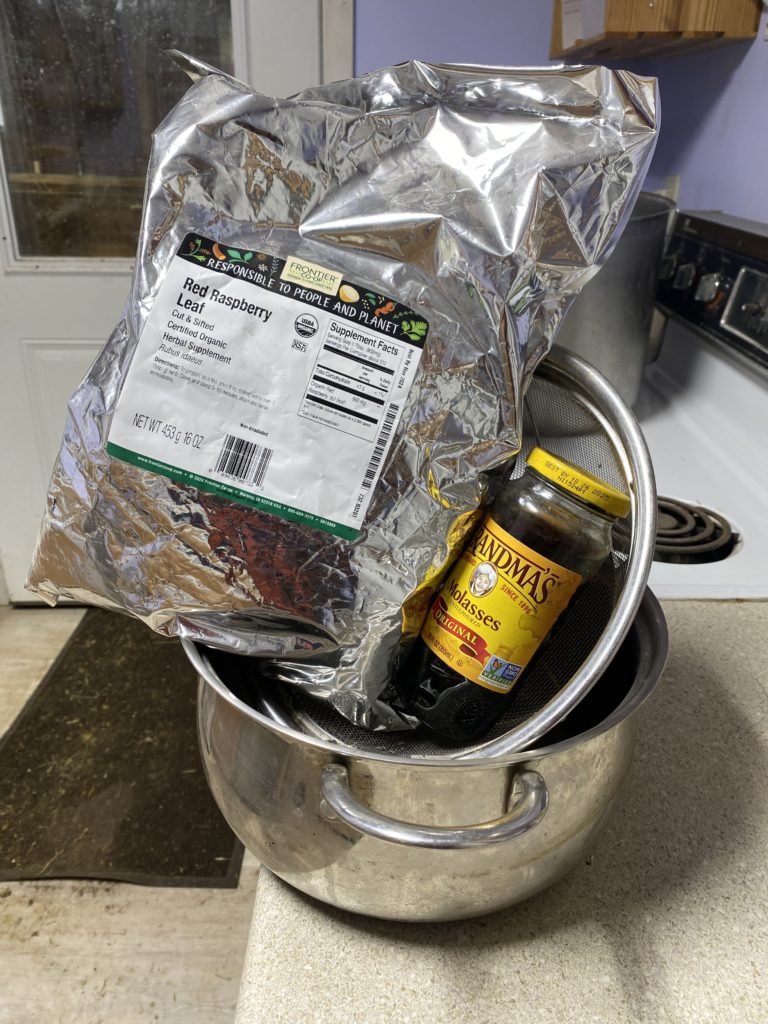
Helps for Distressed Dams/Kids
Styrofoam cooler: About 12″ x 18″ inside. This is used with a hair dryer to warm up chilled kids. (See Part 2)
LA 200 antibiotic: (see above). It’s available at feed stores. Also check your supply of syringes and needles. We have syringes in 1 ml, 3 ml, 6 ml, and 10 ml sizes, and needles from 1/2″ 20 gauge to 1″ 20, 16 and 18 gauge.
Colostrum substitute (or frozen colostrum cubes from last year’s kidding) in case the mom doesn’t make it, or rejects a newborn. Buy fresh from year to year.
Thermometer: rectal type.
Normal temperature is 102° F.
Newborns need to have temps above 100°F to digest colostrum. If a kid is cold (feel mouth to see, or take temp) you must warm them before feeding (whether they nurse from dams or are tube fed.)
Winter kids sometimes get pneumonia, or hypothermia. Read up about distressed goat kids so you can recognize the signs.
Feeding tube: This has two uses.
One is for tube feeding distressed kids, but I use the apparatus far more often for helping very small or weak kids with constipation issues. See Part 3 for more on this.
Again, YouTube videos on tube feeding are a great resource. If you’re new to kidding, watch some while you are waiting for your babies to arrive! It’s easier than you think, but also very scary. You CAN do it, if you have to!
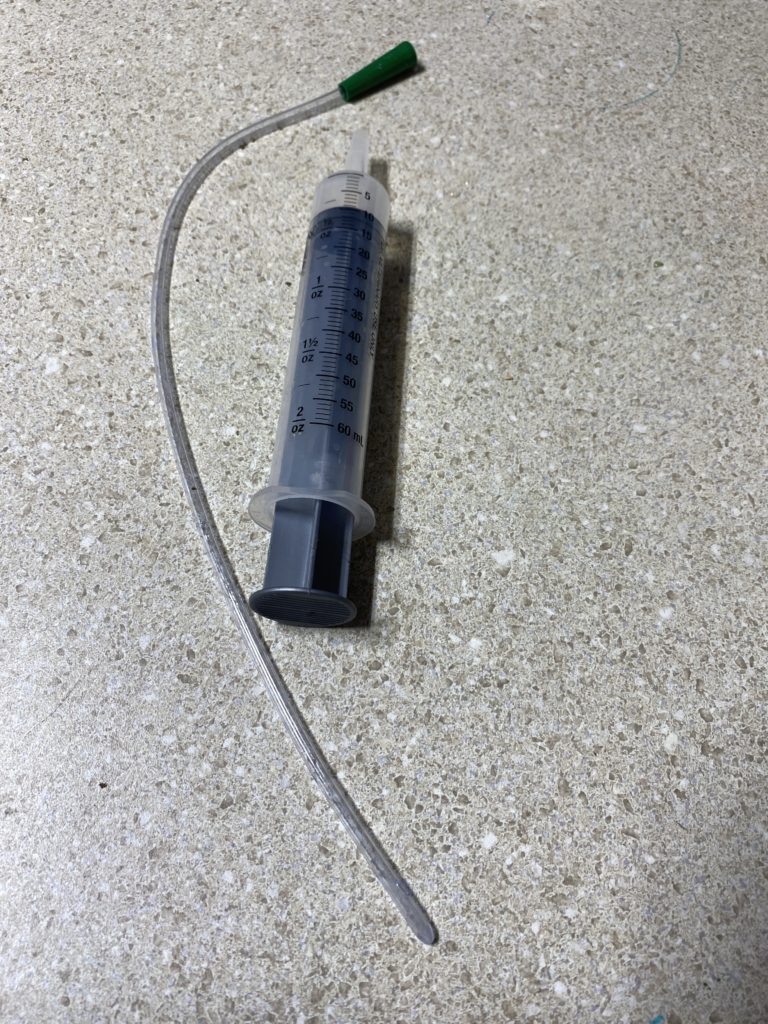
Kidding Stalls or Bonding Pens
Whether or not your doe delivers among her friends in the general population or in a kidding stall is personal preference. We have tried it both ways, and we prefer kidding out in the general pop area (where clean up is easy and goats may be less stressed) and then transfer to a clean, waiting bonding pen with a kid-warming hut, water and minerals, and fresh hay waiting for mom and babies.
There are articles on this website about various pop-up bonding pens/kidding stalls (we are fans of movable, modular goat enclosures) and kid-warming huts made of 50 gallon barrels equipped with heating pads under and heat lamps over. You may need HD (heavy duty) extension cords to supply hair dryers, heat lamps and/or heating pads with power.
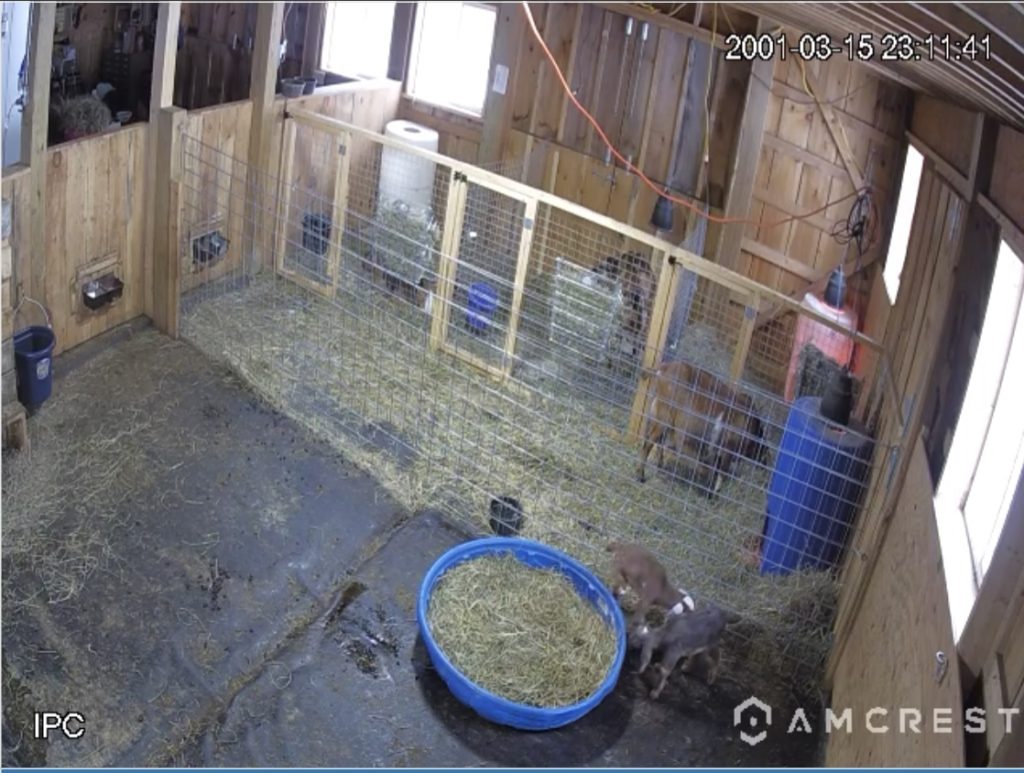
NOTE: We NEVER, EVER leave the heat lamps on when we are not IN the barn. Too many animals and barns have been lost to heat lamp accidents. That said, heat lamps do warm up the hut initially and help newborns to dry off. Since we spend the night in the barn during cold weather (on cots in our heated milking parlor) in order to check on newborns through their first night, we do use the lamps. But, we never leave them on if we’re not there.
In winter, it’s nice to have hot pots (if you don’t have hot running water) in the barn. Does really appreciate warmed water on cold mornings with their alfalfa! Keeping them hydrated (particularly if they are nursing) is very important, and we find that they will readily drink down warmed water quicker than ice water.
We have a newer barn, and it has a heated milking parlor. (Yes, I know how blessed I am!)
The floor of the milking parlor is washable vinyl planking, so it’s pretty slippery for newborns, compared to a barn floor with hay spread. We find this heated room invaluable for warming kids when the barn temperatures are in the low 30°s. As soon as all the kids are born, we bring the doe and kids into this room. At our leisure, they are warmed, dried off, and fed. We then cool the room down slowly, and put the doe and her kids into the bonding pen, with the kids in their warming hut.
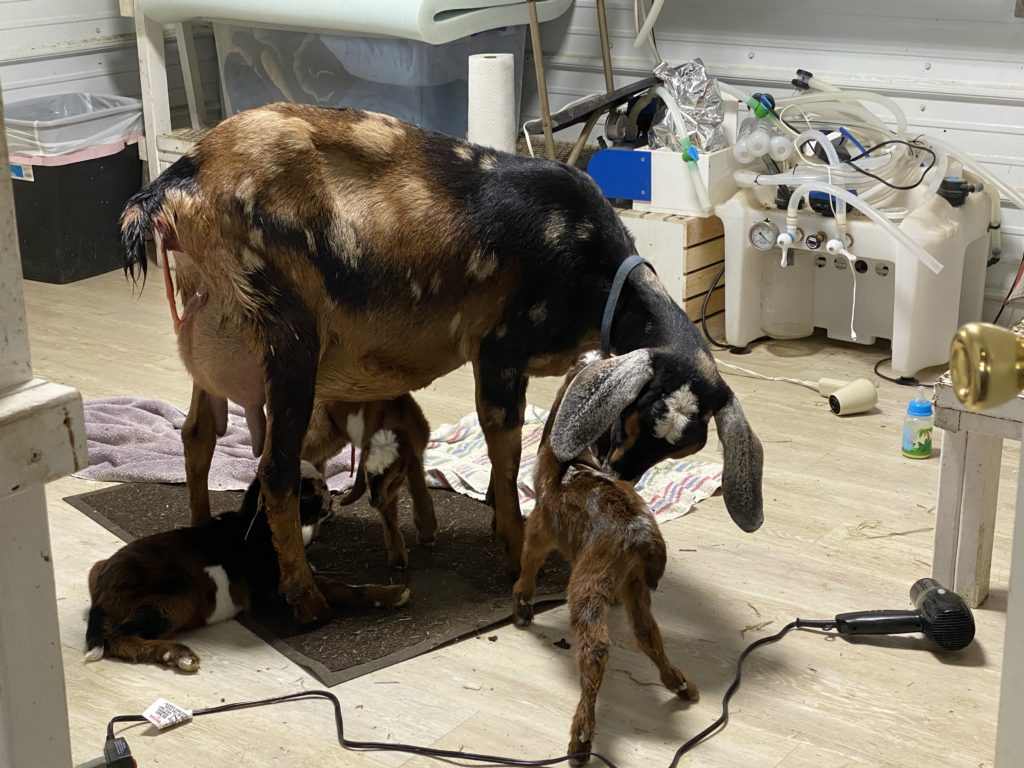
Last year, we bought a piece of inexpensive indoor / outdoor carpeting from Home Depot that we put down for good footing for kids in our milk room. This carpet gets used year after year.
The doe can deliver her placenta here, pee here, or poo here. It’s all good. We wash it off with a hose, or vacuum it with our shop vac, and it’s good to go again.
